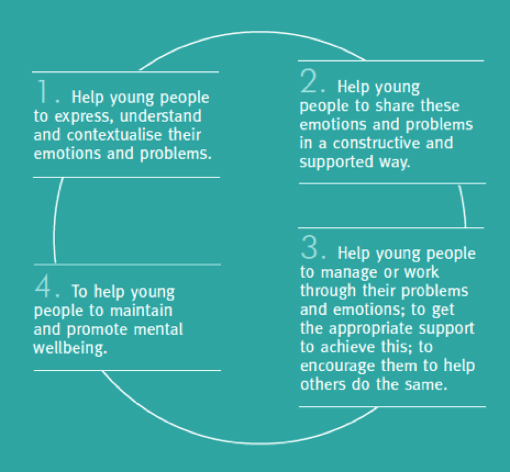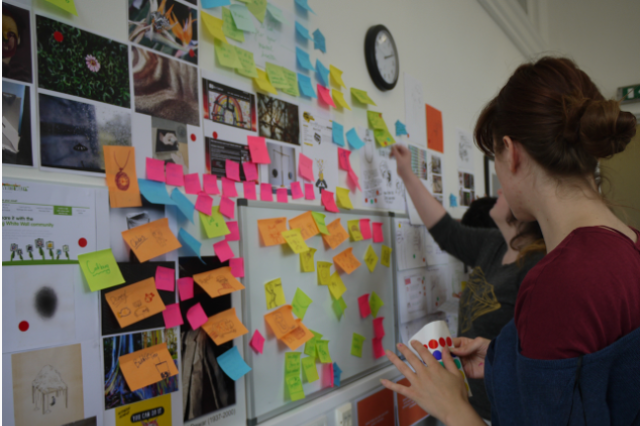Co-design mental wellbeing tools
We ran a range of co-design sessions with young people where they explored the kind of services that would help foster mental wellbeing. Developing the ability to understand, express and share problems and emotions constructively is key to manage mental health and wellbeing.
Throughout the process, four steps to mental wellbeing emerged which sit under each of the potential services that the young people recommended.
Four steps to mental wellbeing

Potential mental health services
Listed below is a range of different mental health services and tools that the young people were interested in:
A multi-media ‘moodtracker’
Young people were interested in a rich ‘moodtracker’ which would express the subtlety of emotions through images, animations and video clips, music, quotes and stories. Users could select and store the content to express their emotional state as richly as possible. It would prompt them to reflect on what they choose and help them work out why.
The tool could help young people prepare their appointments with GPs, counsellors and CAMHS teams. It could help them not only work out their emotions but how best to explain them to someone else. Lengthier counselling sessions could work through the content in greater detail.
Online Communities
Online communities exist in abundance. Their anonymity and solidarity allow vulnerable young people to discuss and find support for issues that they otherwise might not discuss elsewhere.
However, unmonitored communities can affect young person’s wellbeing negatively. Although some online communities self-manage very well, there is a real need (and desire amongst some of the young people we worked with) for properly monitored forum environments. Young people could share advice, stories and support each other, but also receive expert input and guidance.
Experts would act as discussion invigilators, looking out for both the general mood of the discussions and for the wellbeing of individual contributors. They would hide inappropriate comments and contact users they become concerned about. They would also be contactable for users who become distressed or uncomfortable with comments made in the forum.
Allotted ‘question times’ could alternate with more ‘hands-off’ periods, perhaps only responding to alerts. Themes should be framed positively and behaviour expectations set clearly. User would be able to set trigger filters. They would be encouraged to flag anything inappropriate and to be mindful of their own and each other’s wellbeing.
Such professional involvement could prove costly, so the service’s effectiveness would depend on managing users’ expectations of the level of professional involvement, but also on fostering a positive self-regulating forum environment. Further research and co-design would identify how best to achieve this. A young person in the core co-design team suggested that a clear, beautiful and positive identity for the forum space and its ethos would be key.
Named ‘Support2’, the idea shows young people’s natural instinct to seek friendships with those they feel they connect with on certain issues. From this instinct comes the desire for one-to-one conversations with other forum members. Private messaging between forum users is not, however a function that we would recommend, due to all manner of problems with risk. Users would be asked not to give out email addresses and personal details, and this needs to be monitored. Instead, users should be encouraged to attend local community and support groups.
Helping others
A huge number of young people, who may not be experiencing mental health problems of their own, act as support for those who are, often without fully realising that this is what they are doing.
It is important to recognise their role and to provide them with a space to do this effectively, vent concerns, and learn to look out for their own mental wellbeing whilst bearing another’s burden. Friends and peers might allow support services to contact otherwise hard-to-reach young people. Equally, the premise that young people are seeking support for a friend rather than themselves might make them more comfortable to reach out.
‘Supporting the supporters’ could include a host of services; sharing stories, forums, and advice on what to say and do in different situations – delivered through imaginative and interesting means.
Promoting mental wellbeing
Young people found it difficult to name positive, everyday measures to look after their mental health, in stark contrast to maintaining physical health, which all could discuss confidently. They were interesting in advice to promote good mental health day-to-day.
The most comprehensive and ambitious idea was an extensive campaign extending beyond a single digital asset to the school curriculum and opportunities for private companies and third sector groups. A range of techniques, mediums, styles – and most likely celebrity endorsements – would be needed to tie in with Internet trends amongst young people.
Crucially, the information would need to be in a format easy to adapt and share and may require a well-publicised event to act to stimulate interest. Active user participation would create sustained impact: for example, sharing a positive thought, image or action daily in social media could encourage others to take action.
Managing mental illness
This is in close relation to the previous point, but specifically targeted at those managing a mental condition. The young people highlighted the benefits of ‘to-do’ lists and schedules that remind you to enact certain positive behaviours and give you a sense of reward for carrying out simple tasks.
Feeling that you are able to take practical steps to help you manage an illness daily is important. With the proliferation of smart phones, a calendar-type app designed specifically for different kinds of mental health management could prove a valuable digital asset. There is also an interest in sharing practical tips and positive coping mechanisms through a variety of online formats.
Empathy tools
The young people wanted to see and hear heartfelt, non-glamorised accounts of what it is like to live with mental illness day-to-day. Shared stories would not only help those suffering from mental ill health to contextualise their situation, but would also help fight stigma. People could use a variety of formats: video, audio including song and spoken word, comic illustration, or simply written.
Emergency Instant Messaging
Young people, as ‘digital natives’, are very much at home communicating via instant messaging and online chat. Some vulnerable young people in distress might find it easier to reach an emergency service that way rather than phoning a helpline. Some may even feel an inability to call for help.
This would be in addition to the phone and drop-in options provided by organisations such as the Samaritans. This would of course require significant training and infrastructure.
Exploring gaming
Discussions around gaming featured more frequently during the initial sessions than the co-design sessions, probably because the second group was entirely female.
During the engagement sessions, young people suggested that gaming might be useful to help young men, in particular as an empathy tool or emotional release.
One gender-neutral game that was put forward consists of looking after the physical and mental health of a virtual pet – thereby teaching young people how to best look after themselves.
‘Humour’ as a support Tool
Humour, used appropriately, is a powerful tool. Young people with recognised mental health problems were frustrated to see mental health issues addressed too delicately, seriously, or clinically and with ignorant insensitivity.
A well-informed, humorous approach would be favourable; gauging this would require a careful co-design. Using humour as a tool to enable young people to make light of their own situation constructively in order to better cope with it and to share it. Simultaneously insensitive jokes need to be called out as unacceptable.
Make it beautiful
Digital assets should have distinct, interesting and beautiful identity and ethos, and clear expectations for use and behaviour. It is important to set the mood and personality of a digital space as carefully as that of a physical space. When a digital space is bland and without clear rules and aims, its identity becomes solely defined by a critical mass of users. Whilst this may create positive results, it also allows negative behaviours to push to the fore unchecked.

Share this blog
